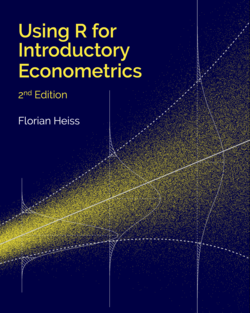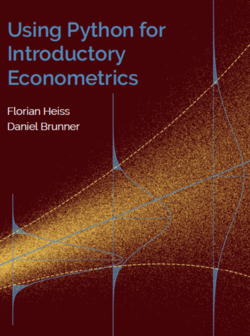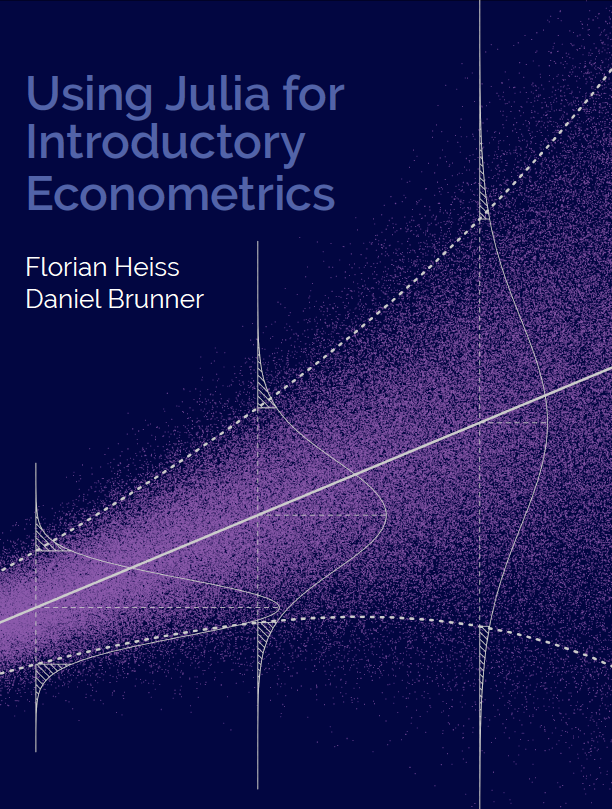Using R, Python and Julia for Introductory Econometrics
Welcome
…to the companion web site to the books
- Using R for Introductory Econometrics
- Using Python for Introductory Econometrics
- Using Julia for Introductory Econometrics



They can be
- purchased as a hardcopy at Amazon.com (R, Python, or Julia) or other retailers for a list price of USD 26.90 (or at international Amazon Websites such as Amazon.co.uk), Amazon.de, Amazon.co.jp, Amazon.fr, Amazon.it, or others)
- downloaded as a fully functional PDF copy here (use any PDF reader, search, print, …)
Content and Approach
The books introduce the popular, powerful and free programming languages and software packages R, Python or Julia with a focus on the implementation of standard tools and methods used in econometrics. Unlike other books on similar topics, it does not attempt to provide a self-contained discussion of econometric models and methods. Instead, it builds on the excellent and popular textbook “Introductory Econometrics” by Jeffrey M. Wooldridge. Some other editions and versions work as well, see below. It is compatible in terms of topics, organization, terminology and notation, and is designed for a seamless transition from theory to practice. Topics include:
- A gentle introduction to the respective language (R, Python or Julia)
- Simple and multiple regression in matrix form and using black box routines
- Inference in small samples and asymptotics
- Monte Carlo simulations
- Heteroscedasticity
- Time series regression
- Pooled cross-sections and panel data
- Instrumental variables and two-stage least squares
- Simultaneous equation models
- Limited dependent variables: binary, count data, censoring, truncation, and sample selection
- formatted reports and research papers using Jupyter Notebooks combining code with Markdown or LaTeX
Note about other “Introductory Econometrics” versions
- The 7th edition of Wooldridge’s “Introductory Econometrics” was published in 2019.
- The 6th edition of Wooldridge’s “Introductory Econometrics” was published in 2016. Some examples got different numbers, but you will find everything.
- The 5th edition of Wooldridge’s “Introductory Econometrics” was published in 2013. While it misses some parts, it works as well.
- The 5th international edition of Wooldridge’s “Introductory Econometrics” published in 2013 and lacks even more material, but for our purposes it works without any problems.
- Older editions are not perfectly compatible with regard to references to sections and examples.
- The book Introduction to Econometrics by Jeff Wooldridge published in 2014 is officially available in Europe, the Middle East, and Africa only. It is mostly consistent in terms of the main chapters, but does not include exercises, the appendices on fundamental math, probability, and statistics, and other material.
Code
The chapters have the same names and cover the same material as the respective chapters in Wooldridge’s textbook. Assuming the reader is familiar with the concepts discussed there, the books explain and demonstrate how to implement everything in R, Python or Julia and replicate many textbook examples. We also open some black boxes of the built-in functions for estimation and inference by directly applying the formulas known from the textbook to reproduce the results. Some supplementary analyses such as Monte Carlo simulations provide additional intuition and insights. The book is designed mainly for students of introductory econometrics who ideally use Wooldridge’s “Introductory Econometrics” as their main textbook. It can also be useful for readers who are familiar with econometrics and possibly other software packages, such as Stata. For them, it offers an introduction to R, Python or Julia and can be used to look up the implementation of standard econometric methods.
All computer code used in this book can be downloaded to make it easier to replicate the results and tinker with the specifications. Codes can accessed through our
About the Books
In all three book we use the same structure, the same examples, and even much of the same text where it makes sense. This decision was not only made for laziness. It also helps readers to easily switch back and forth between the books. And if somebody worked through the R book, she can easily look up the Python or Julia way to achieve exactly the same results and vice versa, making it especially easy to learn both languages. The books are self-published and not professionally edited. Once you get over the hideous layout and appalling grammar, you can start enjoying the benefits:
- We can do things like offer the full text for online viewing without asking a publisher for permission.
- Compared to your typical textbook, a hardcopy is really cheap.